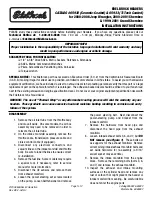
129
USING AND DRIVING
05
• The disabled ESC may be re-enabled if
the ESC OFF switch is pressed again or
the vehicle speed exceeds the 80 km/h
threshold. ESC may be re-enabled only
if the ESC is not in a vehicle dynamic
intervention state.
• ESC OFF switch mis-operation*
• ESC is considered to be mis-operated
if the ESC OFF switch is pressed for
more than 10 seconds. All internal ESC
functions will work normally.
• ESC restart after motor OFF
• After tESC is disabled, restarting the
motor will automatically restart ESC.
• ESC start and speed linkage
• When ESC is disabled, the vehicle
becomes extremely unstable as the
speed increases and exceeds the
80 km/h threshold, and ESC will start
by itself.
• ESC activated
• If the ESC fault indicator blinks,
drive with caution.
• ESC disabled
• Be careful when ESC is disabled,
and drive at speeds suitable to road
conditions. ESC ensures stability and
driving force. Never turn it off unless
necessary.
• Replacing tires
• Make sure all tires are the same size,
brand, tread and total load. Be sure
to inflate tires to the recommended
pressure.
• Neither ABS nor ESC will work properly
if the vehicle is fitted with different tires.
• For details on tire or wheel
replacement, contact a BYD authorized
dealer or service provider.
• Tire and suspension handling
• The use of any defective tires or
modified suspension will affect the
driving safety system and may cause
the system to fail.
Anti-lock Braking System (ABS)
• The ABS hydraulic system has two
separate circuits. Each circuit runs
diagonally through the vehicle (the right
front wheel brake is connected to the left
rear wheel brake). If one circuit fails, two
wheels can still be braked.
• ABS helps maintain steering control
by preventing the wheels from locking
or skidding when brake is engaged
suddenly or on slippery roads.
• When the front tires skid, there is no
steering control, which means that the
vehicle still moves forward even though
the steering wheel is turned. ABS helps
prevent locking and maintain steering
control since pulsating prompt brake is
much faster than human reaction.
• Never pulsate the brake pedal; otherwise,
ABS may malfunction. While steering
away from danger, a firm and steady
pressure should always be maintained on
the brake pedal for the ABS to work. This
is what is sometimes referred to as "a firm
step and a precise turn".
• When the ABS is working, the brake
pedal will vibrate, which may produce
noise. This is because the ABS is in
pulsating prompt brake, which is normal.
How quickly ABS works depends on tire
driving force (adhesion).
Summary of Contents for ATTO 3 2022
Page 1: ...O W N E R S M A N U A L bydauto co nz ...
Page 5: ...4 ...
Page 9: ...8 ...
Page 10: ...ILLUSTRATION INDEX 01 Exterior 10 Dashboard Panel 11 Center Console 12 Door 13 ...
Page 15: ...14 ...
Page 36: ...DASHBOARD 03 Instrument cluster 36 ...
Page 47: ...46 ...
Page 48: ...CONTROLLER OPERATIONS 04 Car Doors and Keys 48 Seats 59 Steering Wheel 62 Switches 65 ...
Page 137: ...136 ...
Page 154: ...07 MAINTENANCE Maintenance Information 154 Regular Maintenance 159 Self Maintenance 163 ...
Page 181: ...180 ...
Page 182: ...WHEN FAULTS OCCUR 08 When Faults Occur 182 ...
Page 190: ...VEHICLE SPECIFICATIONS 09 Data Information 188 Tips 192 ...
















































